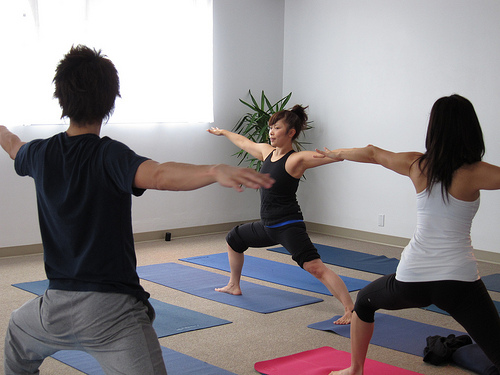An Exercise in Convenience: How Office Meals & Lunch Break Yoga Can Boost Workplace Wellness Participation
Posted by Sara on Thursday, May 22nd, 2014 with 5 Comments
Workplace wellness programs are a true win-win: when done right, employees get healthier, which translates to lower health care costs and a more productive workforce for employers. Even morale and engagement can improve, as employees who feel like their companies care about and support their well-being may find greater meaning in their work. Of course, partaking in wellness-related perks, like healthy office meals, complimentary or reduced-price gym memberships, and even free flu shots, don’t hurt either.
So why is it so tough to get a majority of employees to participate in workplace wellness programs? Really, for all the same reasons it’s tough for any of us to get healthy when we know it’s good for us… it’s just plain hard to start a new habit (or break an old one).
If your company needs a little assistance in the workplace wellness participation department, you’re not alone. A recent study from the Department of Health & Human Services reports that while nearly half of U.S. companies with more than 50 employees offer wellness programs, only 46 percent participate in screenings or health risk assessments, and less than 21 percent participate in intervention-style activities (think smoking cessation and weight loss programs).
Offer incentives
Incentives are one of the most common ways to entice employees into workplace wellness participation. The HHS report suggests that incentives above $50 are fairly effective at compelling participation in health screenings, but less so when it comes to intervention-style programs. This makes sense, because while a health screening is easy to complete, committing to a program that will require major lifestyle changes is a bit more challenging. Don’t just offer a one-time incentive for signing up, but consider offering ongoing rewards for meeting monthly goals. Whether you use cash or alternatives, like gift cards or company swag, incentives are a wonderful way to kickstart motivation.
Prioritize convenience
Whenever possible, make the healthy habits you want your employees to adopt as easy as possible. Host lunch-and-learns right in the office with a focus on wellness-related topics, like nutrition or how exercise can improve mood and mental well-being. Ask a local yoga teacher to hold a weekly class in an empty conference room over the lunch hour. Have a local nurse or clinic set up on-site flu shots. And arrange for the daily option for employees to purchase healthy takeout and delivery through group orders (see our prior posts on the best options to order for sushi, diet-friendly Chinese food, and even healthy deli sandwiches for inspiration!). While healthy habits need to be implemented at home and work, there’s no reason not to make it easy to follow through with at the office.
Eliminate hypocrisy
Are you espousing healthy eating, but have a vending machine stuffed with chips and cookies in the break room? Do you encourage employees to hit the gym, but maintain a strict schedule that makes it difficult to fit in a workout? Sending mixed signals like these to employees results in only one message coming through loud and clear: wellness isn’t really a priority. Make sure the actions of the company lines up with wellness, and the cultural message will be much more straightforward.
Make it a team effort
While you should emphasize that the results of health screenings will remain confidential on an individual basis, there’s nothing wrong with building teamwork amongst coworkers as part of your wellness plan. Create a running club or form an office team for an upcoming 5k run to build accountability. Form a company softball team, or even just hold twice-daily exercise breaks in an empty conference room — play upbeat music, have a big pitcher of green iced tea, and ask coworkers to replace their coffee break with a low-impact (zero-sweat) stretching session.
Building community, eliminating hypocrisy, making wellness convenient, and offering incentives: each category can consist of small actions with big potential. And when it comes to promoting employee wellness by providing access to healthy, wholesome office meals in the workplace, Waiter.com makes it easier than ever to support your company’s wellness culture!
When it comes to feeding employees and coworkers, make your company's food program really count! If your workplace dining plan needs to take it up a notch — or if you don't have one at all — Waiter.com is here to help. From Virtual Cafeteria Service to diverse menus to local takeout & delivery, Waiter.com offers customizable dining solutions for every business and budget. Contact us today to get started!




I think it is a great idea to get employees together on clubs. I however work in a hospital and work swing shift. We have a softball team that practices in the evenings. What are some ideas to make sure that all employees are able to participate in these wellness activities? I think it would be a great idea to offer 15 min yoga sessions during break times ! Also it would be a good idea to get rid of the junk food from inside the vending machines. By having it we send a negative message not only to employees but patients as well.
Thanks Megan – hospitals are definitely in a unique position as they send messages both to employees and patients, like you said. It seems even more crucial for healthy foods and drinks to be the only option provided (as long as they still taste good, of course!). I love your idea for 15-minute yoga sessions. Even finding a favorite video and letting it queue up on a TV in the break room would go a long way to create a culture of whole-body wellness!
This was a great article for companies looking to make the move in their company to greater health and wellness levels. It said it in the article itself that only 21% of people participate in health wellness programs and this article helps show those companies trying to make the jump that these are the most successful ways to do it. Incentives are a big part. You want to get the attention of an employee? Offer them more money. Plain and simple. This gets the attention of anyone working, and if that does not work, make sure you market the overall new vibe of the office to be completely focused on “being healthy”. Eliminate all those things that put out negative vibes to “bad foods” such as those vending machines that only offer chips and cookies. Allow everyone in the office to see that this company is putting on a new and improved shirt. One that promotes long living and healthy lifestyles. As it said in the article, it will bring everyone in the office closer together sharing a common goal that promotes overall healthier living! Not only by increasing teamwork skills in the office, but you also save on health care cost and like it said, a more productive workforce from having more energy couldn’t hurt either!
This is great information and I hope more employers read and listen to it. It works! I know this firsthand. When I lived in NH, I worked for a progressive woman’s clothing company that offered healthy meals in the onsite cafe and they also had an onsite gym that was complimentary. I enjoyed working out every morning before hitting the office. They didn’t offer any incentives though. But like the stats said, about half or a little less took advantage. Employers listen up! It works!
Thanks for your thoughts! It’s true – even less progressive companies can get onboard without spending a ton of money on onsite cafes or gyms.